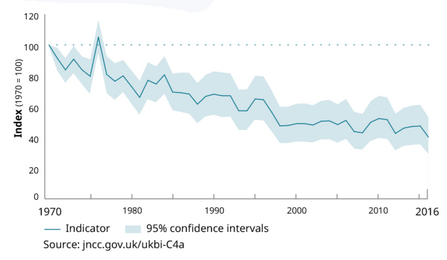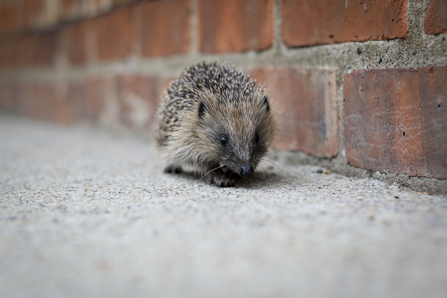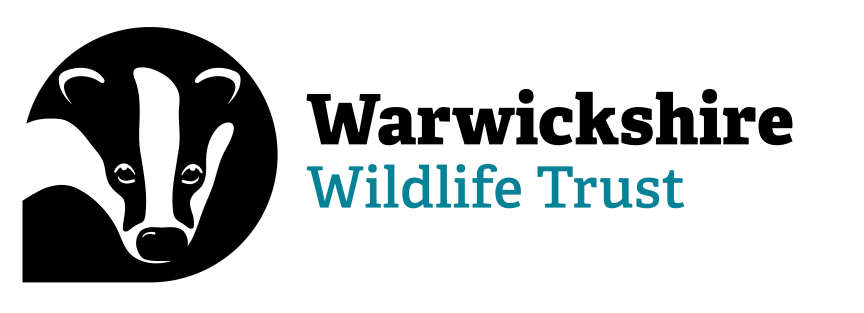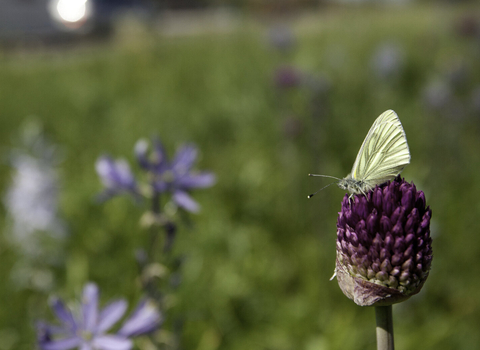Bringing Wildlife Back
The natural world is in a critical condition. Unless we act now we are on the edge of the next mass extinction. Our own personal behaviour and the systems and laws that should be keeping nature healthy are failing both wildlife and people.
What sort of future do you want the next generation to inherit? Should their world be wildlife rich or poor?
UK Biodiversity Indicator: Change in the relative abundance of UK priority species, 1970 to 2016
Abundance indicator (214 species)

Declines in the UK
Distressingly, the UK is now cited as one of the most nature depleted countries on earth, with 1 in 10 species under threat from extinction ¹. Since 1970, we have lost about half of our wildlife, as shown in the graph above. The UK Government’s own assessment indicates that the UK will not meet most of the global targets to reverse these declines ². Sadly, the situation in Warwickshire is an accurate reflection of what is happening across the UK. This has to change now.
How can you make a difference?
We need to act locally to play our part in helping nature’s recovery, here, across the UK and globally. This is a once in a generation opportunity to not only slow the decline, but to bring our wildlife back.
Our solution is to acquire land to create new nature reserves, which will enable a bigger, better and more joined up landscape where our wildlife can thrive and people can get closer to nature in their daily lives.
Backed by evidence
For twenty years our Habitat Biodiversity Audit team have been working with partners carrying out ecological surveys across our area. Thanks to their work, we know where existing different wildlife habitats are, and how connected they are within the Warwickshire landscape. What this means is that, in broad terms, we know what needs to happen to bring about nature’s recovery in Warwickshire, Coventry and Solihull.
Plans for the future
Nationally, the Wildlife Trusts believe that there needs to be at least 30% of land and sea enabling nature’s recovery across the UK. Across a range of different species, at less than 30% cover in a landscape, habitat patches become small and isolated and species richness (the number of species in any one area), abundance and survival rates decline ³. At more than 30%, habitat patches will generally be larger and the distance between patches will typically be less so they are better connected together. This means that if local extinctions do occur other populations of the same species can move into the area easily.
Based on this 30% threshold we can answer the question, how wild are Warwickshire, Coventry and Solihull?
|
Wildlife Habitat by Local Authority |
% coverage in 2020 |
Habitat Deficit |
|
Coventry City Council |
8% |
22% |
|
North Warwickshire Borough Council |
13% |
17% |
|
Nuneaton & Bedworth Borough Council |
9% |
21% |
|
Rugby Borough Council |
10% |
20% |
|
Solihull Metropolitan Borough Council |
6% |
24% |
|
Stratford-on-Avon District Council |
16% |
14% |
|
Warwick District Council |
14% |
16% |
|
Warwickshire, Coventry & Solihull |
13% |
17% |
Warwickshire, Coventry and Solihull are not wild enough for nature!
Our response
While those figures are stark, we have a plan.
Back in 1970, local people came together to establish our charity in response to a crisis. At that time, precious sites for nature were under threat from human development. There was an urgent need to identify, safeguard and protect the best sites for wildlife. Over 50 years, helped by our passionate members and volunteers, we have secured these sites for rare and vulnerable wildlife across Warwickshire, Coventry and Solihull, establishing over 65 magnificent nature reserves. Now, in 2020, we need to look forward to the next 50 years and be even more ambitious.
We are going to change the way we acquire new nature reserves. We will give highest priority to acquiring land with low existing wildlife value because the potential to bring wildlife back is greatest there. We will target land that is difficult to farm productively, and where our investment can have the biggest impact for wildlife and people. We will secure land through purchase, donation or long-term agreements in the right areas to create bigger, better and more joined up areas for wildlife.
We will then look to improve these sites for wildlife, increasing the overall land area which has high wildlife value across our region and contributing towards the 30% target. This approach also creates more publicly accessible sites to bring you closer to nature on your doorstep. Making space for nature helps to create healthy soils for growing more food, clean air to breathe, clean water and green space for exercise, not to mention flood management, carbon capture and mitigating climate change.
At the same time, we will continue to work in partnership with local councils, farmers and landowners, and local businesses, to inspire and support them to make space for nature on their land.
So these are our ambitious plans for Warwickshire, Coventry and Solihull. Working with other Wildlife Trust’s throughout the UK, we will ensure that 30% of our land and sea is used to put nature into recovery by 2030. Will you help us realise this ambition? Donate today and help bring wildlife back to where you live.
Bringing Wildlife Back

Tom Marshall
References
- Newbold T, et al. (2016) Has land use pushed terrestrial biodiversity beyond the planetary boundary? A global assessment. Science 353: 288–291. [the UK’s biodiversity is 81.0% intact, which is below the global average of 84.6%, and is the 29th lowest value of the 218 countries for which estimates are available]
- JNCC. 2019. Sixth National Report to the United Nations Convention on Biological Diversity: United Kingdom of Great Britain and Northern Ireland. JNCC, Peterborough. [the UK government’s self-assessment concludes it failed on two-thirds of targets (14 out of 20) agreed at the Convention on Biological Diversity in Nagoya, Japan, in 2010]
- References:
Andrén, H. (1994) Effects of habitat fragmentation on birds and mammals in landscapes with different proportions of suitable habitat: a review. Oikos 71(3): 355-366
Peterken, G. (2000) Rebuilding Networks of Forest Habitats in Lowland England. Landscape Research 25(3): 291-303
Peterken, G.F. (2003) Developing forest habitat networks in Scotland. In: The restoration of wooded landscapes Proceedings of a conference held at Heriot Watt University, Edinburgh, 14–15 September 2000. Eds: Humphrey, J., Newton, A., Latham, J., Gray, H., Kirby, K. H., Poulsom, E. and Quine, C. Forestry Commission, Edinburgh, pp. 85-91.
Fahrig, L. (1998) When does fragmentation of breeding habitat affect population survival? Ecological Modelling 105: 273-292.
Fahrig, L. (2001) How much habitat is enough? Biological Conservation 100: 65-74.
Radford, J.Q., Bennett, A.F. and Cheers, G.J. (2005) Landscape-level thresholds of habitat cover for woodland-dependent birds. Biological Conservation 124(3) 317-337

